Time table 40 steel pipes are one of the most often used pipes in an expansion of programs, together with industrial, production, and plumbing systems. The NPS indicates the approximate diameter of the pipe, while the wall thickness varies depending on the NPS. To decide the perfect pipe size for particular programs, a schedule 40 pipe size chart is critical. This chart gives details on various pipe sizes, consisting of their outdoor diameters, wall thicknesses, and internal diameters. Knowledge of these Schedule 40 Steel Pipe Dimensions-size/thickness/chart helps ensure that the proper pipe is chosen for the favored software, optimizing overall performance and safety.
Schedule 40 Pipe Dimensions and Their Importance
The scale and thickness of Schedule 40 pipes are critical in figuring out their suitability for diverse programs. These pipes are widely utilized in plumbing, production, and business settings, wherein the thickness immediately impacts their strength, durability, and strain-managing potential. Expertise why the thickness of Schedule 40 pipe topics is crucial for making informed choices about which pipes to apply in different contexts, making sure protection, overall performance, and toughness.
Thickness and Pressure Handling Capability
In fluid delivery systems, the thickness of Schedule 40 pipes determines their capacity to handle internal pressures. Thicker pipes can face up to better inner pressures without bursting, making them ideal for transporting excessive-stress fluids or gases. This capability is critical in industries that include oil and gasoline, chemical processing, and municipal water delivery, where preserving pressure without leakage or pipe failure is crucial for safe and green operation.
Impact on Corrosion Resistance and Longevity
Thicker schedule 40 pipes generally provide better resistance to corrosion, which is a common issue in piping systems exposed to water, chemical substances, or harsh environmental situations. The increased cloth thickness presents a buffer against corrosive factors, prolonging the pipe’s lifespan. In applications like water remedies, marine environments, and chemical flora, the usage of thicker pipes can reduce preservation fees and downtime related to pipe alternatives or repairs because of corrosion.
Importance in Thermal Resistance and Temperature Management
In programs regarding extreme temperatures, together with industrial boilers or chemical reactors, the thickness of Schedule 40 pipes performs an important role in thermal resistance. Thicker pipes can face higher temperatures and thermal cycling without losing electricity or turning into deformed. This belonging is critical in stopping pipe failure due to thermal enlargement and contraction, ensuring steady overall performance and safety in temperature-touchy environments.
Effect on Pipe Weight and Installation Requirements
The thickness of Schedule 40 pipes additionally influences their weight, which could affect set-up approaches and structural help necessities. Thicker pipes are heavier, necessitating more robust support systems and probably growing installation time and fees. In applications wherein weight is a concern, inclusive in high-upward thrust homes or long-span piping systems, choosing the best thickness is crucial to balance sturdiness with workable weight.
Material Efficiency and Cost Implications
While thicker schedule 40 pipes offer several benefits, in addition, they require greater material, which may boom charges. The know-how of the precise requirements of a utility allows in for optimizing pipe thickness to ensure cloth performance without compromising safety or overall performance. For instance, the usage of a thicker pipe in which a thinner one could suffice ends in pointless fees, while the usage of a pipe that is too thin can bring about disasters and better long-term fees.
Compatibility with Fittings and Connections
The thickness of Schedule 40 pipes influences their compatibility with numerous fittings and connections, including flanges, valves, and couplings. Making sure that the pipe thickness suits the specs of those components is vital for maintaining an easy and leak-free connection. In structures in which a couple of pipes and fittings are used, mismatched thicknesses can lead to uneven stress distribution, increasing the danger of joint failure or leakage.
Optimizing Flow Characteristics and Hydraulic Efficiency
The thickness of Schedule 40 pipes can affect their internal diameter, which impacts flow traits and hydraulic performance. Thicker pipes may have a slightly reduced internal diameter, doubtlessly impacting glide rates and stress drop. In packages in which hydraulic performance is crucial, inclusive in water distribution or irrigation systems, selecting the right pipe thickness is essential to keep the most effective float prices and limit electricity consumption.
Conclusion
The thickness of Schedule 40 pipes is an important concern in figuring out their suitability for diverse applications. Through expertise in how thickness influences structural integrity, pressure handling, corrosion resistance, thermal resistance, weight, value, compatibility, regulatory compliance, and hydraulic performance, selection-makers can pick out the best pipe dimensions for their specific wishes. Balancing those elements guarantees the most useful performance, safety, and cost-effectiveness in numerous piping systems, from residential plumbing to industrial processing.

